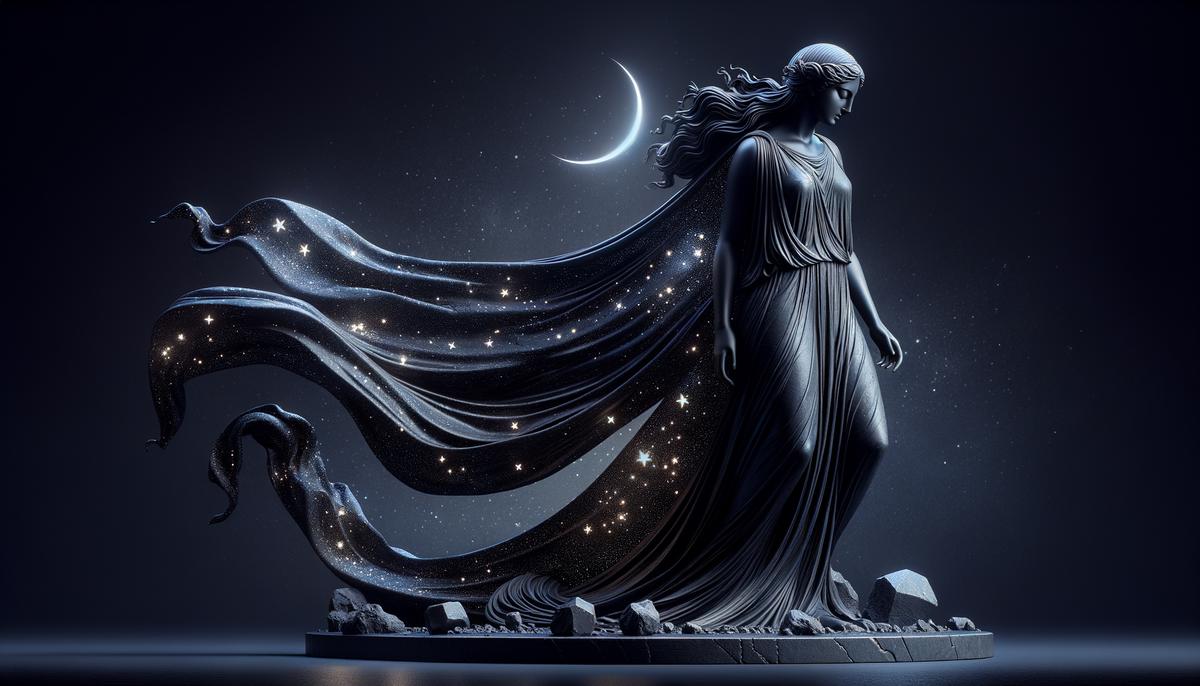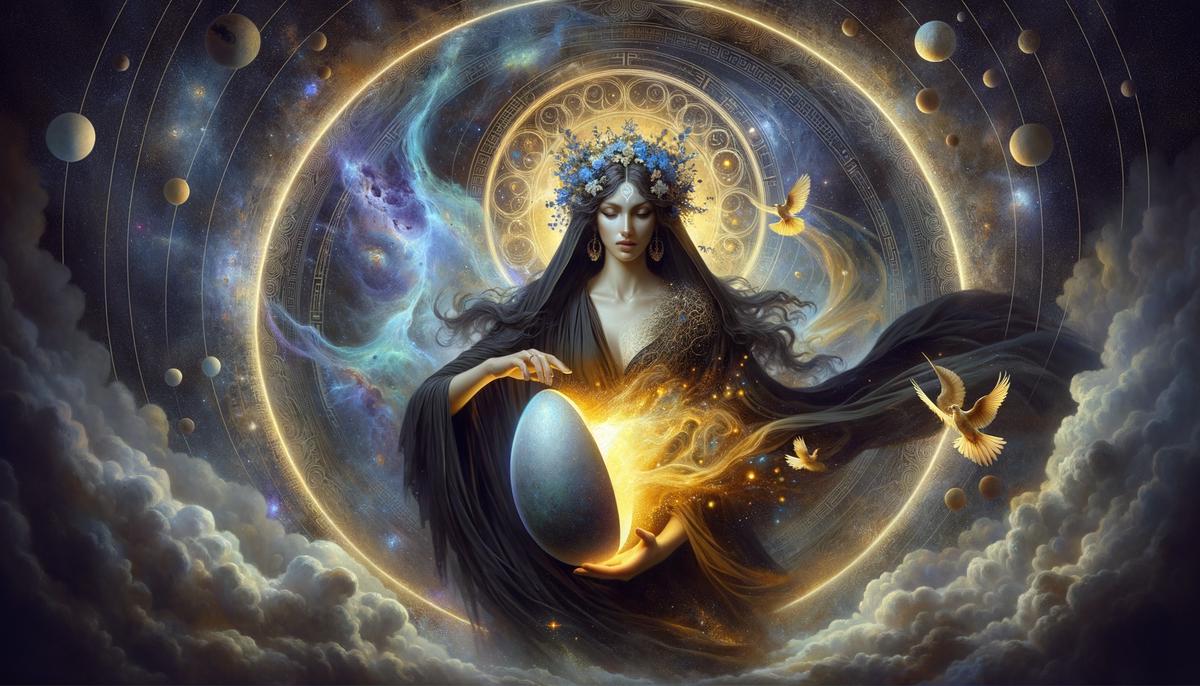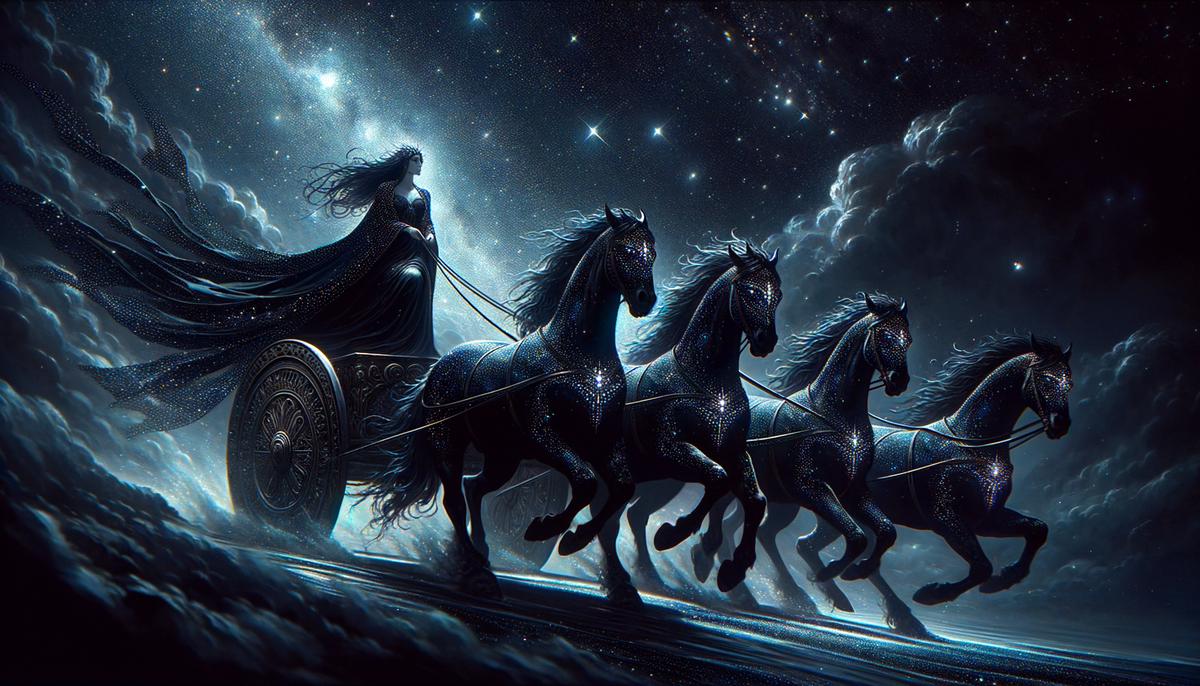Origins and Family of Nyx
Nyx emerged from primordial chaos and epitomizes the essence of night, cloaking the world in darkness with her nightly voyage across the sky. Her partner in this creation of night and day was Erebus, the embodiment of shadow and darkness. Together, they birthed two elemental deities, Aether (Brightness) and Hemera (Day). The dance between Hemera departing as Nyx arrives illustrates their eternal cycle of day chasing night and night chasing day.
Nyx's offspring embody a sprawling range of human emotions and fate, including:
- Moros (Doom)
- Thanatos (Death)
- Hypnos (Sleep)
- The Oneiroi (Dreams)
Each child holds sway over fundamental human experiences. Thanatos embodies mortality, while his brother Hypnos ushers in rest and respite.
Among her darker spawns stand notable figures such as Nemesis, the goddess of retribution who balances out human pride with precise justice. Another is Eris, known for sowing discord.
Despite her chilling progeny, Nyx carries respect among mortals and gods. High among the stars, she rides her chariot, drawing forth the night, each entrance graced with celestial phenomena that herald her presence.
Her influence spans both terror and tranquility. These tales carry whispers of primeval days where Nyx reigned supremely over night's domain. This array secures Nyx's status not merely as a figure of night but as a pivotal architect of the cosmos' continuous cycle. Her narrative threads demonstrate how energy shifts from dusk till dawn—a testament to her ultimate sway in the celestial sphere.

Symbolism and Influence of Nyx
Nyx's role as the night personified brings deep symbolism that permeates through ancient and modern cultures. Her black veil represents the unknown—everything concealed from mortal sight. This embrace with the mystery of night stimulates the human psyche, conjuring both fear and curiosity. Night has inspired countless poets, philosophers, and dreamers to explore the hidden depths of their souls.
Human fascination with night paints Nyx as a maternal figure who wraps the world in her dark embrace, offering respite through slumber. Yet, she also oversees realms filled with shadows and secrets. Cultures around the world have whispered her name in awe as the sun sets, inviting us to ponder life's mysteries that only come forward under the cover of darkness.
Artistically, Nyx is often envisioned shrouded in mystery and draped in starlit robes—a fusion between strength and gentleness. Sculptures and paintings depict her adorned with stars, riding her chariot across the sky, or gently sprinkling sleep and dreams. Such depictions underscore her dichotomous nature, as a herald of both doom and gifts.
Nyx's perceived control over life and death played a pivotal role in her worship. Her capacity to navigate this balance showcases her as a sublime cosmic force. Ancient peoples invoked her name with a hushed reverence suitable for one who commands the darkness.
The psychological impacts of night on day-to-day life also paint a portrayal of Nyx's softly authoritative touch on cultures. Nighttime rituals, storytelling under stars, or the soulful silence are all within Nyx's purview. In these shadows, human societies found place for contemplation and celebration of life. These nightly occurrences hinged upon her passive approval in mythology, captivating elder Greek societies and translating into intimate cultural expressions.
In modern metaphorical applications, Nyx would be akin to the shadow that lurks just around the corner—the instinctual fear of dark molded by her mythos. This blend of beneficial and ominous attributes illustrates her legacy; one embedded into our understanding of nightly renewal and inherent frights conjured during sprawling darkness.
While Nyx was not one of the central deities worshiped explicitly in elaborate temples, her indispensable essence permeated daily living and philosophical inquiries—a testament to her profound psychological weave through the human narrative under twinkling celestial bodies she commands.

Nyx in Art and Worship
Nyx's enigmatic allure and omnipresence in the nocturnal hours have inspired a spectrum of artistic expressions over millennia. In visual accounts, she's frequently portrayed shrouded in darkness yet crowned with the cosmos, reflecting her dominion over night. Artists in ancient Greece depicted this goddess on pottery and frescoes, showcasing her as a winged figure soaring through the night sky, often with stars caressing the edges of her dark veil.
Formal temples dedicating worship to Nyx were scarce. However, Nyx was revered in practices and rites, particularly within the enigmatic Orphic tradition—an esoteric offshoot of Greek religion that held the Night goddess in prominence. The Orphics embraced Nyx as a central figure who emerged from Chaos and was instrumental in the creation of the universe. In texts and rites, she was depicted as an almighty mother who spun the stars into the sky and laid the groundwork for time itself.
Transitioning into contemporary settings, Nyx's ancient spell continues to resonate. Her name has danced into pop culture and branding with a mysterious grace. 'Nyx' isn't just whispered by scholars; it has transgressed into the world of commerce. Brands like NYX Professional Makeup borrow her persona to market cosmetics that aim to empower.
The seduction of Nyx's name extends into the cosmos, lending it to one of Pluto's moons. This celestial nomad, caught in an eternal dance around its planetary host in the dark void, carries the name of our ancient goddess of night. Each course around Pluto stands as a homage to the Nyx who once adorned Greek narratives with her fundamental powers.
As twilight sinks each evening, enveloping the world in its secretive embrace, we partake in a ritual as old as myths—where Nyx shadows over civilization's bustle with as much sovereignty now as she did when poets first sang her into existence under starlit skies. While her frontline worship has waned, Nyx's essence—a mix of mystery, protectorate, and dread—lingers in meditations and mythologies that echo life's all-consuming cycle spun by primordial night.
Nyx's Role in Orphic Religion
In the undercurrents of Orphic religion, Nyx is not merely a backdrop but rather the cosmic weaver of fate and the black velvet of the infinite sky—that unseen force pulsating through the veins of the universe. The Orphic traditions present a divergence from classical Greek theology. Here, Nyx is elevated from her familiar nocturnal reign to an omnipotent matriarch of the cosmos.
Orphic texts unveil Nyx as a prime originator. According to Orphic cosmogony, Nyx existed before the elements and gods came to fruition. Orphism envisions Night not as an absence of Light but as a profound entity that existed before the structured chaos of sea and sky solidified.
This ancient sect pictured the universe as an egg. Nyx, in her boundless womb, encapsulates this universal egg. Within it, she cradles Phanes, also known as Eros, who is another inclusion diverging from mainstream Greek tales where Eros is frequently seen as a cherub of love.
With Phanes sprung forth from the Orphic egg, often gleaming with golden wings, he ushers in creation, representing the luminous impetus for life's dance. The Orphic schema puts Nyx in a consultant role thereafter, eternally whispering cosmic counsel into the ears of ascending gods like Zeus. This advisory capacity highlights another dimension of Nyx's sovereignty—her wisdom and pervasive influence directing the orchestration of cosmos.
The contrasts between this perspective and mainstream portrayals of Greek gods are stark. In canonical texts, Nyx conducts her celestial rounds without much fanfare—commanding, but distant. Within Orphism, her narrative expands; she transfigures into a foundational deity, deeply interwoven with the existence and guidance of all cosmic life forms.
This transformation in role and reverence captures a unique facet of Greek spiritual expression—one that transcends stories told by starlight and ventures into existential ponderings. To Orphic devotees, Nyx was the original architect, her domain preceded daylight's reign. It's an imagining that provokes awe—a rumination on what foreboding might lie within night's shroud.
Nyx's depiction in Orphism marks a vital blend of fear, veneration, mystery, and maternal omnipotence—traits that sculpt an enigmatic but influential deity navigating through the depths of a pre-Hellenistic midnight. The Orphic reverence for Nyx isn't just about honoring the goddess but also recognizing her as a primordial core, extrapolating truths about the universe's beginnings and its mystique-fueled continuance.

Nyx's Interaction with Other Deities
Nyx's interactions with other deities highlight her formidable presence and influence. In one myth, her son Hypnos, the god of sleep, found himself in a bind involving Zeus. Hera, plotting against her husband, convinced Hypnos to lull Zeus into a deep slumber. Despite his hesitation, Hypnos eventually agreed, causing Zeus to fall asleep and inadvertently unleash a tempest against the hero Heracles.
When Zeus awoke and discovered the deception, he was furious and sought retribution against Hypnos. Fearing Zeus's wrath, Hypnos fled to his mother Nyx for protection. Nyx, wielding her dominion over the night, confronted Zeus. Even the mighty Zeus, known for his thunderbolts and tempests, hesitated before Nyx, demonstrating the respect and perhaps even fear he held for her. Rather than incite her anger, Zeus stayed his vengeful hand, showcasing Nyx's protective nature and her unspoken authority among the divine hierarchy.
This incident not only highlights Nyx's maternal instincts but also positions her as a pivotal figure whose neutrality and influence are acknowledged by all on Mt. Olympus. Her essence permeates interactions, lending weight to the nocturnal and mysterious aspects she governs.
Nyx's connections with other entities further emphasize her significance across mythologies. In lesser-known tales, Nyx's interactions with the Moirai, also known as the Fates, whom she mothered, detail her involvement in determining the destinies of both mortals and immortals. Ancient texts suggest that her counsel was sought by many deities seeking to navigate the unpredictable streams of fate, solidifying her position as a wise and insightful advisor.
Through these mythological snapshots, Nyx's narrative extends beyond simply ushering in the night. She becomes a guardian of heavenly secrets, wielding her power with quiet subtlety that enhances her immortal intrigue. Each celestial tale woven with her at its core reveals additional layers to this enigmatic goddess, firmly intertwining her into the fabric of Greek cosmology as a force both nurturing and awe-inspiring.

In the rich tapestry of Greek mythology, Nyx stands out as a deity whose essence is as vast as the night sky itself. Through her various roles—from a protective mother to a wise cosmic counselor—Nyx embodies a captivating blend of reverence and mystery, leaving a lasting impact on both ancient beliefs and modern perceptions. Her narrative, filled with emotional depth and celestial intrigue, continues to fascinate those who venture into her starlit realm.

Leave a Reply